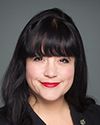That's excellent.
For clarification, are you saying every language we would like to add to a ballot would have to be added into legislation?
Evidence of meeting #13 for Procedure and House Affairs in the 44th Parliament, 1st Session. (The original version is on Parliament’s site, as are the minutes.) The winning word was chair.
A video is available from Parliament.
11:20 a.m.
Liberal

The Chair Liberal Bardish Chagger
That's excellent.
For clarification, are you saying every language we would like to add to a ballot would have to be added into legislation?
11:20 a.m.
Chief Electoral Officer, Elections Canada
No. Thank you, Madam Chair.
The legislation right now presumes two things. First, it uses the Latin alphabet. Secondly, it uses the name as it appears on the candidate nomination supported by voter ID. That could well be in Greek, English, French or an indigenous language. There's no restriction. As long as the ID supports it, it's acceptable. However, the alphabet has to be the Latin alphabet.
11:20 a.m.
Liberal

The Chair Liberal Bardish Chagger
That's brilliant. I just wanted that clarification. Thank you.
Mr. Turnbull, you have six minutes.
11:20 a.m.
Liberal

Ryan Turnbull Liberal Whitby, ON
Thank you, Madam Chair.
Thank you to Mr. Perrault and team for being here. I'm sorry I couldn't be there with you in person. Nonetheless, I have lots of questions, as always, and look forward to this study. I think it's a really important one. I was a member of PROC in the last Parliament, where this was suggested under some other work we were doing on Bill C-19, which was more pandemic-focused. I'm really glad we're returning to this now, because I think it's really important work.
Mr. Perrault, I'm glad to hear about your commitment to incorporating indigenous languages and increasing indigenous participation. I think we all recognize that those are not exactly the same. Indigenous participation is far more than just including indigenous languages on ballots. This is an important aspect of that conversation. Thank you for outlining the four options and for contrasting them with some of the policy, operational and electoral integrity challenges or concerns you have. I think that's really helpful. Your opening remarks were quite well taken.
I have three lines of questioning. We'll see if we get to all of them. One of them is trying to unpack the conversation a little in terms of the threshold. One of the options you highlighted in your opening remarks on multilingual ballots was the threshold of 1%, which I think is interesting for us to consider. I wanted to contrast that. I understand that in the last election, you already tried to incorporate supporting documentation in indigenous languages. Based on the work you already did in the last election, what languages were selected? How did you make decisions about which indigenous languages to offer supporting documentation in?
I think that might highlight how you determined that threshold or what threshold was kind of implicit in what you were already doing in the last election. Could you unpack that for us a bit?
11:25 a.m.
Chief Electoral Officer, Elections Canada
Absolutely.
Madam Chair, I'll separate the two things. First, with the threshold we used, we were assuming that the threshold was based on mother tongue. It could be based on language first spoken at home, or it could be based on the written language that is understood. We may not have data on all of these criteria, so that is something we need to unpack to understand which threshold we use. For the purpose of today's presentation, I used the mother tongue threshold.
On the 16 languages we use, that has been built over time, based on Statistics Canada data regarding mother tongue. It also includes some more historical groups for which, in the past, based on demand, we have offered products. It's a mix of percentages and on demand.
I can't give you a clean answer. I can certainly say that if we were to apply the 1% threshold, the 17 languages I speak of in my remarks largely overlap with the 16 languages for which we currently offer information products. I think there are a few that differ, but they mostly overlap.
11:25 a.m.
Liberal

Ryan Turnbull Liberal Whitby, ON
Thank you, Mr. Perrault. I appreciate that.
What other options might there be for defining the threshold? I'm interested in that, because I think you've talked about a couple. It sounds like it's related to capacity mother tongue or percentage of the population who speak that indigenous language. Are there any others you can think of that we might consider?
11:25 a.m.
Chief Electoral Officer, Elections Canada
Madam Chair, it's a very good question. That's why we want to experiment further. I think we need to look at the threshold but also look on the ground at the demand and the capacity to offer translation or transliteration.
I don't have an answer today. I think one of the things I want to do in the next election is try to explore as much as possible, using those languages that we currently use, and see where we can go and where we find obstacles. It may be that, given the calendar in an election, some may not be possible despite a threshold. I would come back to this committee on that.
11:25 a.m.
Liberal

Ryan Turnbull Liberal Whitby, ON
Great. Thank you for that, Mr. Perrault.
Through the chair, you also highlighted, Mr. Perrault, ballot facsimiles. I thought that was a really interesting potential solution, which I think you highlighted as having a lot of potential. I'm wondering whether you got any response and positive feedback on that in Nunavut in the last election. Could you tell us about any feedback you received?
11:25 a.m.
Chief Electoral Officer, Elections Canada
Madam Chair, we didn't receive very much feedback. We had no complaints about it. We had some complaints about a few of our items, for example a “Vote Here” poster that was not translated, which I think should be translated. We had some comments about that, but not about the facsimile.
It may be simply that people who live in Nunavut expect to see Inuktitut in documents, so I would speculate that it is something that is not a shock to them. They would expect to see that, so seeing it, they were happy about it. At least, they didn't complain about it, but there's not much we can say from that.
We learn about the processes in terms of our capacity to do it in that language, but there's a lot more that we need to learn.
11:25 a.m.
Liberal

Ryan Turnbull Liberal Whitby, ON
Madam Chair, I have one more question, through you.
Mr. Perrault, in your opening remarks you talked about “in consultation with indigenous communities” and testing this approach further. Based on a need for regular consultation and the commitment you have to indigenous participation and incorporating indigenous languages into ballots or ballot facsimiles.... I know Elections Canada has other advisory groups. Specifically, do you think it would make sense to have an indigenous participation advisory group that could also focus on this issue of indigenous languages? Do you think it would be a good approach to have ongoing consultation and communication?
11:25 a.m.
Chief Electoral Officer, Elections Canada
Madam Chair, it's something that we are currently exploring. I've asked for a program review on how we serve indigenous Canadian electors, and that will include a review on how we engage. In that program review, we will be bringing on board some indigenous Canadians.
One of the questions we want to look at is whether we need an ongoing committee to support us, so that's part of the work ahead for us.
11:30 a.m.
Liberal

The Chair Liberal Bardish Chagger
Thank you.
I'm going to chime in one more time. Do you have somewhat of a plan as to where you would like to see this expanding? Is that information you could share with the committee?
11:30 a.m.
Chief Electoral Officer, Elections Canada
We do not, at this point. We're in the process of setting up the group.
Increasing the language in terms of the pilot project we did in the last election is something that we will work on in the coming months, but at this point I don't have much to offer this committee beyond that. We are getting started on this.
11:30 a.m.
Bloc

Marilène Gill Bloc Manicouagan, QC
Thank you, Madam Chair.
I want to thank the people from Elections Canada for joining us today.
I find your comments very intriguing. I have hundreds of questions. I'll ask several different types of questions, so that I can pinpoint potential grey areas to address. You spoke a great deal about usage and you also mentioned the land. I want to know whether the choice of languages is based solely on these matters when it comes to the services already provided.
We're talking about ballots. However, in terms of voter turnout, the availability of information in people's respective languages remains a barrier. We're talking about 17 languages and 16 languages already included in the services provided. I want to know how many languages there would be, ideally, if usage weren't the only factor.
I also want to know why one of the 17 languages wasn't selected. At least, that's what I understood at the start of your presentation.
11:30 a.m.
Chief Electoral Officer, Elections Canada
The number 17 refers to the 1% population threshold of indigenous people who should be served in their first language. This amounts to 17 languages in Canada. We're currently using 16 languages in our publications on identification and voting. Some information is available in 16 languages. These languages were chosen partly on the basis of population thresholds and partly because of previous requests from some communities.
11:30 a.m.
Bloc

Marilène Gill Bloc Manicouagan, QC
It's about usage and demand.
I imagine that this poses a challenge for you, given that the number of languages is much higher. Is it possible to serve the entire population in their mother tongue or is that unrealistic?
I thought about the facsimiles idea. It can work well in communities. Sometimes, more than one language is spoken, and sometimes only one. I'm trying to imagine an indigenous voter in downtown Montreal. It's a place with multiple diaspora communities.
How would things work with facsimiles? How many languages would be available in the voting booth?
I'm wondering what can be done, whether this model has limitations and whether, at some point, it will be necessary to find another approach in order to serve the entire indigenous population.
11:30 a.m.
Liberal

The Chair Liberal Bardish Chagger
Indeed. I also want to let everyone know that I'm very flexible. When questions come up, if you need more time, I'll give it to you. We want to get more information today. This is a very important discussion.
11:30 a.m.
Chief Electoral Officer, Elections Canada
Yes, Madam Chair.
I think that all paper models have inherent limitations. Some governments in other parts of the world use electronic machines, which make things much easier. Just as you do on the Internet, you choose the interface, the language, and so on. In an electronic environment, the doors to accessibility are wide open. However, it's different with a paper model.
You must consider the feasibility, even in terms of what I consider the simplest model, the facsimile. You couldn't possibly produce a very large number of facsimiles. It would create confusion.
I don't have all the data. However, I know that a number of constituencies have five indigenous language communities, each representing at least 1% of the population. Even with a facsimile model, five language communities is a lot.
I don't really have an answer for you. If you really wanted to have multilingual ballots that included indigenous languages, you would need an electronic voting system.